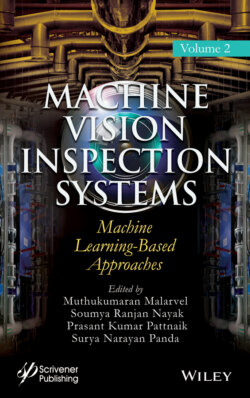Читать книгу Machine Vision Inspection Systems, Machine Learning-Based Approaches - Группа авторов - Страница 16
1.4 Results and Discussion
ОглавлениеThis work uses Orange 3-3.24.1 [56] for the simulation purpose. Several TEMVIs with different sizes are taken from the source [59–88]. In this work, 30 TEMVIs with 6 images of each category such as EV, ENV, LV, SARS-CoV-2 and ZV are taken for testing purpose which is mentioned in Figures 1.2–1.6. The TEMVIs are processed using ML-based classification techniques such as LR, NN, kNN and NB. The classification results of these techniques are mentioned in Figures 1.7–1.10, 1.11–1.14, 1.15–1.18, 1.19–1.22, 1.23–1.26 by considering number of folds (NoF) as 2, 3, 5, 10 and 20 respectively. In this work, five different cases such as cases-I–V are considered by taking five different NoF such as 2, 3, 5, 10 and 20 respectively.
Figure 1.2 Ebola virus images (1–6) with sizes 331 × 152, 254 × 198, 203 × 248, 189 × 267, 266 × 190, and 259 × 194 respectively.
Figure 1.3 Entero virus images (1–6) with sizes 225 × 225, 250 × 201, 225 × 225, 214 × 235, 191 × 264, 209 × 190 respectively.
Figure 1.4 Lassa virus images (1–6) with sizes 251 × 201, 180 × 180, 259 × 194, 241 × 209, 262 × 192, 299 × 168 respectively.
Figure 1.5 SARS-CoV-2 virus images (1–6) with sizes 225 × 225, 256 × 197, 254 × 198, 243 × 207, 249 × 203, 300 × 168 respectively.
The test and score calculation is carried out by using cross validation sampling mechanism with different NoF. The classification results generated by using confusion matrix for each of these classification techniques represent actual and predicted values by showing the number of instances. The correct classification results are represented by the help of light blue color and the misclassification results are represented by the help of light red color. Table 1.1 represents the CA values by applying the LR, NN, kNN and NB classification techniques.
Figure 1.6 Zika virus images (1-6) with sizes 225 225, 202 × 250, 225 × 225, 211 × 239, 244 × 207, 236 × 213 respectively.
Case-I (NoF = 2)
Figure 1.7 Classification result by applying LR technique.
Figure 1.8 Classification result by applying NN technique.
Figure 1.9 Classification result by applying kNN technique.
Figure 1.10 Classification result by applying NB technique.
Case-II (NoF = 3)
Figure 1.11 Classification result by applying LR technique.
Figure 1.12 Classification result by applying NN technique.
Figure 1.13 Classification result by applying kNN technique.
Figure 1.14 Classification result by applying NB technique.
Case-III (NoF = 5)
Figure 1.15 Classification result by applying LR technique.
Figure 1.16 Classification result by applying NN technique.
Figure 1.17 Classification result by applying kNN technique.
Figure 1.18 Classification result by applying NB technique.
Case-IV (NoF = 10)
Figure 1.19 Classification result by applying LR technique.
Figure 1.20 Classification result by applying NN technique.
Figure 1.21 Classification result by applying kNN technique.
Figure 1.22 Classification result by applying NB technique.
Case-V (NoF = 20)
Figure 1.23 Classification result by applying LR technique.
Figure 1.24 Classification result by applying NN technique.
Figure 1.25 Classification result by applying kNN technique.
Figure 1.26 Classification result by applying NB technique.
From the analysis of Figures 1.7–1.26 and Table 1.1, it is observed that NB technique provides better classification results with CA values 0.667, 0.733 and 0.767 as compared to LR, NN and kNN when the NoF is 2, 10 and 20 respectively. Again, NB and kNN techniques provide better classification results with CA value 0.633 as compared to LR and NN technique when the NoF is 3. Similarly, NB and NN techniques provide better classification results with CA value 0.667 as compared to other techniques when the NoF is 5. Here, the maximum CA value is 0.767 which is provided by NB technique when the NoF is 20. So, CA value varies for each technique when different NoF are considered. However, NB technique attempts to provide better classification results in three different cases such as cases-I, -IV, and -V. In case-II, NB and kNN provide same CA values as 0.633 and in case-III, NB and NN provide same CA values as 0.667. However, the number of instances present in different cells of confusion matrix varies for the classification results of NB and kNN in case-II as well as NB and NN in case-III. So, NB technique is able to provide better classification results overall as compared to other technique.
Table 1.1 CA (in unit) of different classification techniques.
| Method | NoF = 2 | NoF = 3 | NoF = 5 | NoF = 10 | NoF = 20 |
|---|---|---|---|---|---|
| LR | 0.567 | 0.533 | 0.633 | 0.567 | 0.600 |
| NN | 0.567 | 0.567 | 0.667 | 0.667 | 0.667 |
| kNN | 0.467 | 0.633 | 0.600 | 0.633 | 0.633 |
| NB | 0.667 | 0.633 | 0.667 | 0.733 | 0.767 |
